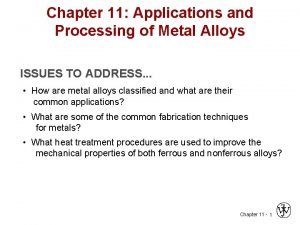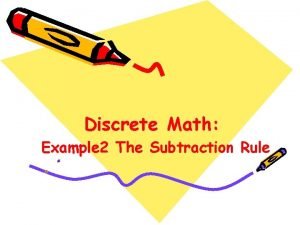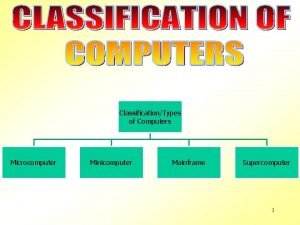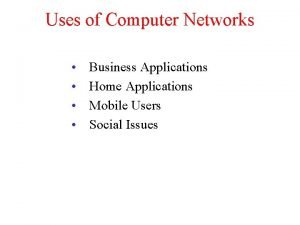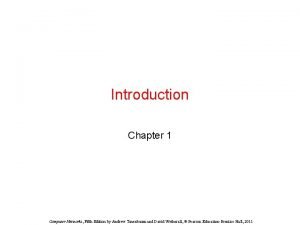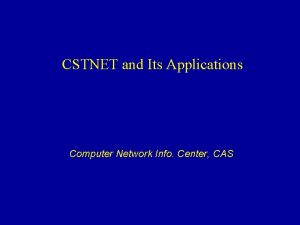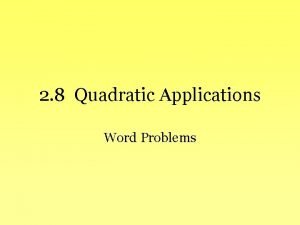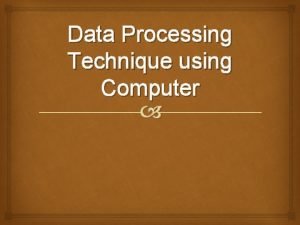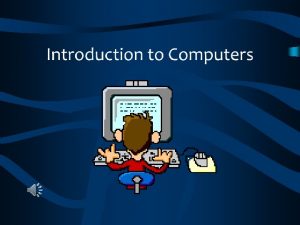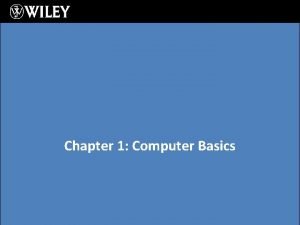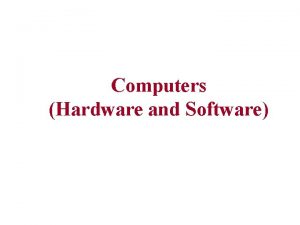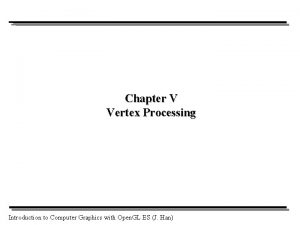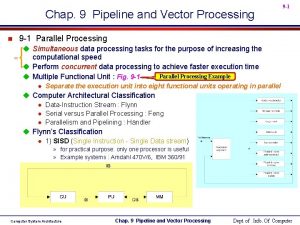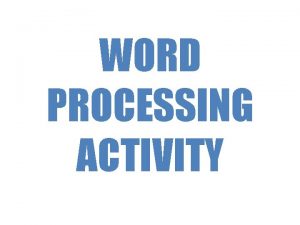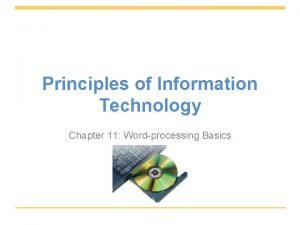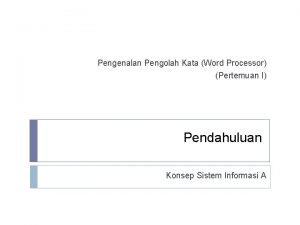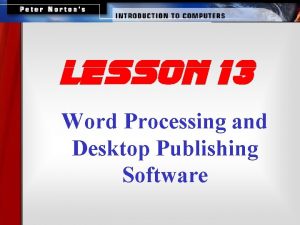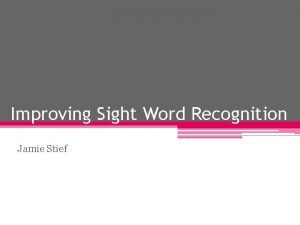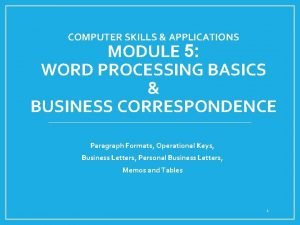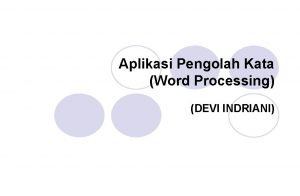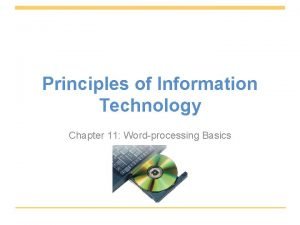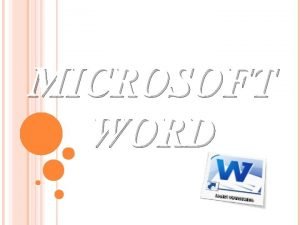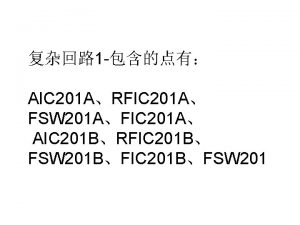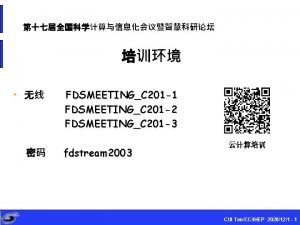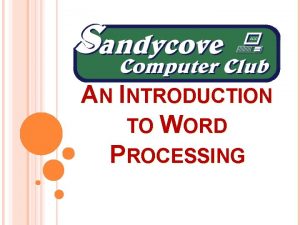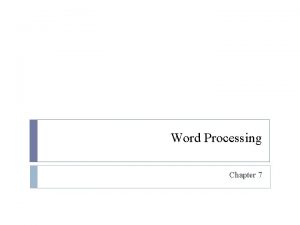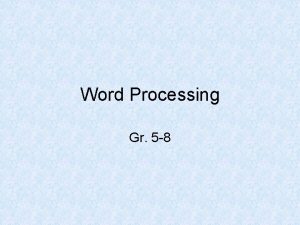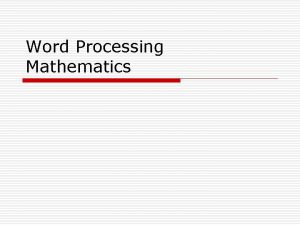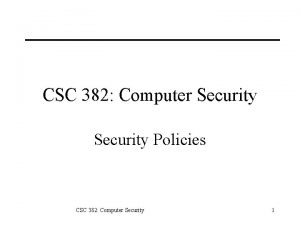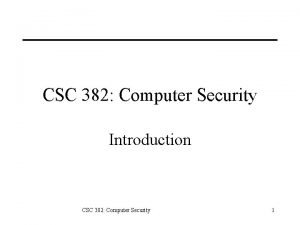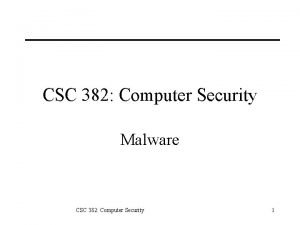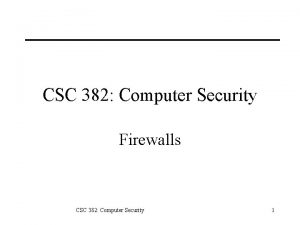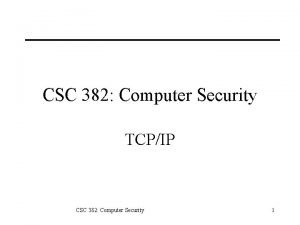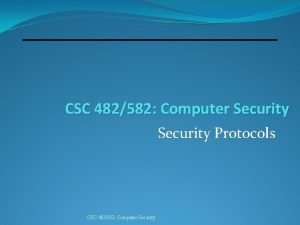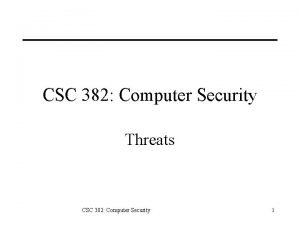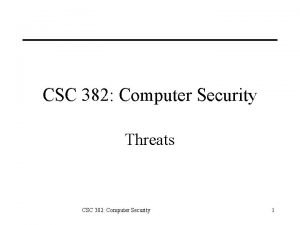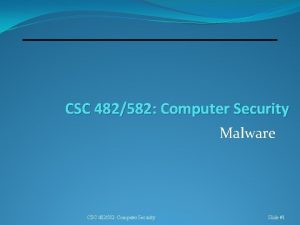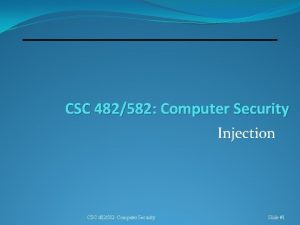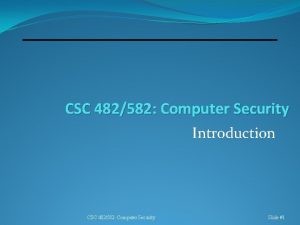Word Processing CSC 201 Computer Applications 2 Getting
















































- Slides: 48

Word Processing CSC 201: Computer Applications

2 Getting familiar with MS Word • It is a non-free text processing software package • Used mainly for text editing

3 Graphical User Interface Ribbon Quick Access toolbar Title Bar

4 Ribbon Tabs Buttons Font Group Dialogue Box Launcher

5 Ribbon Tabs

6 Text Area Vertical Scroll Bar Horizontal Scroll Bar Zoom Bar

7 Quick Access Toolbar • Next to the Microsoft Word Button. • Provides you with access to commands you frequently use. • To add commands to your Quick Access Toolbar, press the arrow and check which commands you want to add.

8 Undo & Redo • You can quickly reverse most commands you execute by using Undo. If you then change your mind again, and want to reapply a command, you can use Redo. Undo Redo Example: 1. Click the Undo button on the Quick Access menu. The typing disappears. 2. Click the Redo button on the Quick Access menu. The typing reappears.

9 View ft Dra • Draft View ▫ Draft view is the most frequently used view. You use Draft view to quickly edit your document. • Web Layout ▫ Web Layout view enables you to see your document as it would appear in a browser such as Internet Explorer. • Print Layout ▫ The Print Layout view shows the document as it will look when it is printed. • Reading Layout ▫ Reading Layout view formats your screen to make reading your document more comfortable. • Outline View ▫ Outline view displays the document in outline form. You can display headings without the text. If you move a heading, the accompanying text moves with it.

10 Ruler • The Ruler is found below the Ribbon. Tool for setting Tab Stops � Indent Markers If your ruler is not visible: 1. Click the View Tab. 2. Click the check box next to Ruler in the Show/Hide group. The ruler appears below 1 the Ribbon 2

11 Creating a simple Document 1. Open MS Word 2016. 2. Click the File Tab. 3. Click New. 4. Choose a blank document, or choose from a template.

12 2 3 4

13 Formatting a Paragraph 1. Place your cursor anywhere in the second paragraph of the sample text. 2. Choose the Page Layout tab. The default spacing appears in the Spacing Before field. 3. Click the up arrow next to the Spacing Before field to increase the space before the paragraph. 4. Click the up arrow next to the Spacing After field to increase the amount of space after the paragraph.

14 Line Spacing and Indentation Click this button to open the Paragraph Dialog Box Special Indentation for the first line of the paragraph Set the alignment of the text to Left, Right, Centered, or Justified Set the spacing between two lines of the same paragraph (i. e. 1. 15 lines)

15 Choosing a Style Set 1. Choose the Home tab. 2. Click Change Styles in the Styles group. A menu appears. 3. Click Style Set. A menu appears. You can choose from any of the styles listed on the menu. 4. Click Simple (or any other Style Set). Word 2016 reformats all of the paragraphs into the Simple style.

16 Applying Styles

17 Creating a new style Click on Modify for further options

18 Choose a style name Adjust style format Adjust Paragraph formatting and other options

19 Inserting a picture Caption 2 - Add a small description next to the caption 1 - Right Click on a picture, and select Insert Caption 3 - Click OK

20 Creating a table 1 - Choose Insert, Table 3 - Choose the number of rows and columns 4 - Click OK 2 - Click Insert Table

21 Modifying table borders 2 - Select Design, Borders 1 - Select the part of the table that you want to modify 3 - Add or Remove the borders of the table

22 Header and Footer • Double click on the Top of a page in the Print Layout view to add a page Header. (The header is usually common to all the pages in the same section) • Double click on the Bottom of a page in the Print Layout view to add a page Footer. (The footer is usually common to all the pages in the same section)

23 Inserting Page Numbers 1 - Select Insert, Page Number 2 - Choose the number format that you want

24 Formatting Page Numbers 1 - Select Insert, Page Number 3 - Choose the desired Number Format 4 - Choose the first number in page numbering 2 - Click on Format Page Numbers

25 Removing page numbering from the first page 2 - Tick the box next to Different First Page 1 - Double click on the page number in the header or in the footer 3 - Now you are able to modify the Footer and the Header of the first page of the section separately

26 Columns 3 - Choose the needed format 1 - Select Page Layout, Columns 4 - Choose the number of columns 2 - Click on More Columns

27 Section Breaks • Use to divide one document into multiple parts, each one being independent from the others. • This will allow: Ø Different Page Layout (Portrait/Landscape). Ø Different Page Numbering Scheme. 1 - Select Page Ø Different Page Headers/Footers. Layout, Breaks Note: A Page Break forces the following text to start on a new page, but the text remains in the same section 2 - Select the desired Section Break

28 Inserting a Table of Contents 1 - Select References, Table of Contents Important Note!: The table of contents will not work if you don’t use appropriate styles (i. e. : Heading 1, Heading 2, and Heading 3…) 2 - Select the desired format Or choose Insert Table of Contents for advanced options

29 Document Review The Spelling and Grammar pane will appear on the right. For each error in your document, Word will try to offer one or more suggestions. You can select a suggestion and click Change to correct the error.

30 Document Review To change the automatic spelling and grammar check settings: 1. Click the File tab to access Backstage view, then click Options. 2. A dialog box will appear. On the left side of the dialog box, select Proofing. From here, you have several options to choose from. For example, if you don't want Word to mark spelling errors, grammar errors, or frequently confused words automatically, simply uncheck the desired option.

31 Document Review

32 Tracking Changes • Track Changes is a way for Microsoft Word to keep track of the changes you make to a document. You can then choose to accept or reject those changes. (Useful when many people working on the same document) 1 - Select Review, Track Changes 2 - Text additions are tracked 3 - Text deletions are also tracked

33 Personal Bullet Design 1 - Select Home, Bullets 2 - Click on Define New Bullet

34 Changing Margins and Orientation 1 - Select Page Layout, Margins 2 - Choose the desired margins You can also change the orientation from portrait to landscape You can also set each margin separately by using Custom Margins

35 Automatic Updates 1 - Select Insert, Date & Time 2 - Choose the desired format, tick Update automatically, and then press OK

36 Citations and Bibliography

37 Citations and Bibliography

38 The Clipboard Panel • You can open the Clipboard panel by clicking on its launcher in the Clipboard group on the Home tab. • When you do, you will see the current contents of your clipboard (i. e. the last thing you copied). Whenever you copy some new selection of text or an image, it will be added to the top of the list. It’s not just items you copy in your Office programs that get copied; text and images from a web page, for example, will appear in the list if you copy them.

39 The Clipboard Panel • You might be wondering what use a list of recently copied items is. Well, the magic happens when you click on an item in the list. When you do, it gets pasted into your document where your cursor is positioned.

40 Equation Inking • To add your own ink equation, go to the Insert tab and click on the down arrow at the bottom of the Equation command. Select Ink Equation.

41 Equation Inking • In the writing area that opens up, draw out your equation with your mouse. Alternatively, if you have a touch device, you can use your finger or a touch stylus to write math equations by hand, and Word 2016 will convert it to text.

42 Tell Me Tool • If you need to perform a particular task, but you don’t know how to, you can type words or phrases related to your task into the Tell Me tool. This new tool can be found in the ribbon, whichever tab you are on. When you start typing, Word suggests commands that are related to your keyword. For example, when you type “theme”, Word will suggest the following:

43 Quick Search • When you want to research and write about a topic for your college paper or school project, use Researcher in Word 2016 to give you a jumpstart in writing your paper.

44 Quick Search • With Researcher you can search for any topic on the web, refer to research articles, insert images and content from the web into your document - all of it without leaving the Word document.

45 Enhanced Collaboration When you open a shared document on One. Drive, at a glance you can see who is working within the document and where. You can chat with collaborators in real time by using Skype for Business, and can view document activity, all from the top-right corner on the ribbon.

46 Enhanced Collaboration Choose a thumbnail picture of a person to begin an IM conversation by using Skype for Business or open their contact card information. Choose the Skype for Business button to start a group chat with everybody working in the document. The new Activity pane lets you see the complete list of changes made so far, and gives you access to the earlier versions. Choose Activity on the ribbon to see the Activity pane. Now with one click of on the ribbon you can make or view comments in your document. With enhanced collaboration, it's easier to reply to or resolve comments and mark them as complete.

47 Changing Theme • The default Office 2016 theme is called Colorful, and looks like this:

48 Changing Theme • You can change the default theme for Word 2016 (and all the other Office 2016 applications work like this) by clicking File > Account, and then change the Office Theme dropdown selector. :
 The secret of getting ahead is getting started
The secret of getting ahead is getting started The word computer comes from the word compute which means
The word computer comes from the word compute which means Systems applications and products in data processing
Systems applications and products in data processing Sap systems applications and products in data processing
Sap systems applications and products in data processing Applications and processing of metal alloys
Applications and processing of metal alloys Bottom up processing
Bottom up processing Gloria suarez
Gloria suarez Bottom up and top down processing
Bottom up and top down processing Point processing and neighbourhood processing
Point processing and neighbourhood processing What is secondary food processing
What is secondary food processing Define point processing
Define point processing Histogram processing in digital image processing
Histogram processing in digital image processing Parallel processing vs concurrent processing
Parallel processing vs concurrent processing Neighborhood processing in digital image processing
Neighborhood processing in digital image processing Point processing in image processing
Point processing in image processing Gonzalez
Gonzalez Top down processing example
Top down processing example Interactive processing
Interactive processing Uses of computer networks in business applications
Uses of computer networks in business applications Subtraction rule discrete math
Subtraction rule discrete math Mini computer usage
Mini computer usage Principles of network applications in computer networks
Principles of network applications in computer networks Objectives of computer applications
Objectives of computer applications Computer integrated manufacturing applications
Computer integrated manufacturing applications Elements of computer
Elements of computer Computer networks and internets with internet applications
Computer networks and internets with internet applications Business application in computer network
Business application in computer network Business application in computer network
Business application in computer network Nhpce
Nhpce Quadratic application word problems
Quadratic application word problems Face detection viola jones
Face detection viola jones Data processing using computer
Data processing using computer Computer processing cycle
Computer processing cycle Information processing cycle of computer
Information processing cycle of computer A computer system consists of both hardware and software.
A computer system consists of both hardware and software. Vertex processing in computer graphics
Vertex processing in computer graphics Pipeline processing in computer architecture
Pipeline processing in computer architecture Example of commercial data processing
Example of commercial data processing Pipeline and vector processing
Pipeline and vector processing Activity for microsoft word
Activity for microsoft word Four part processing model for word recognition
Four part processing model for word recognition Principles of word processing
Principles of word processing Pengertian word processing
Pengertian word processing Desktop publishing software features
Desktop publishing software features Four part processing model for word recognition
Four part processing model for word recognition Sight word ninja
Sight word ninja Word processing packages
Word processing packages Aplikasi word processing
Aplikasi word processing Principles of word processing
Principles of word processing




